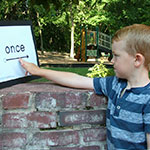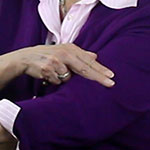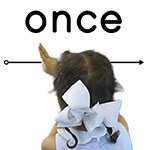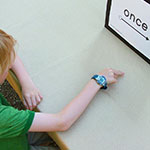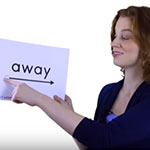NEW Lessons page
A. See & Say
A child sees the word on the flash card and says the word while underlining it with her finger.
B. Spell Reading
The child says the word and spells out the letters, then reads the word again.
C. Arm Tapping
The child says the word and then spells out the letters while tapping them on her arm.
D. Air Writing
A child says the word, then writes the letters in the air in front of the flash card.
E. Table Writing
A child writes the letters on a table, first looking at and then not looking at the flash card.
Corrections Procedure
Correct a child’s mistake by clearly stating and reinforcing the right word several times.
1. Overview
A sight words instruction session should be about 30 minutes long, divided into two components:
- Sight Words Lesson — Use our Teaching Techniques to introduce new words and to review words from previous lessons — 10 minutes
- Sight Words Games — Use our games to provide reinforcement of the lesson and some review of already mastered sight words to help your child develop speed and fluency — 20 minutes
Use lesson time to introduce up to three new words, and use game time to practice the new words.
2. Introduce New Words
When first beginning sight words, work on no more than three unfamiliar words at a time to make it manageable for your child. Introduce one word at a time, using the five teaching techniques below. Hold up the flash card for the first word, and go through all five techniques, in order. Then introduce the second word, and go through all five teaching techniques, and so on.
These techniques work together to activate different parts of the brain. The exercises combine many repetitions of the word (seeing, hearing, speaking, spelling, and writing) with physical movements that focus the child’s attention and cement each word into the child’s long-term memory.
This lesson should establish basic familiarity with the new words. This part of a sight words session should be brisk and last no more than ten minutes. As your child gets more advanced, you might increase the number of words you work on in each lesson.
2.1 See & Say
The child sees the word on the flash card and says the word multiple times while underlining it with her finger.
Adult: Let’s learn a new word. My turn. Ready? ONCE.
Again: ONCE.
What word?
Child: ONCE.
Adult: Yes! I ONCE was a little girl.
Now it’s your turn.
Child: ONCE.
Adult: Again.
Child: ONCE.
Adult: One more time.
Child: ONCE.
Adult: Good job!
2.2 Spell Reading
The child says the word and spells out the letters, then reads the word again. He should underline the word on the flashcard every time he says the word.
Adult: Let’s spell-read this word. My turn.
Ready? FLY. F-L-Y. FLY.
Again: FLY. F-L-Y. FLY.
Your turn.
Child: FLY. F-L-Y. FLY.
Adult: Again. Get ready!
Child: FLY. F-L-Y. FLY.
Adult: One more time.
Child: FLY. F-L-Y. FLY.
Adult: Good job!
2.3 Arm Tapping
The child says the word. Then she uses her right hand to tap out the letters of the word on her left arm, moving left to right, from her shoulder toward her wrist. Then she says the word again.
Adult: Let’s arm-tap the word.
My turn. Ready? SAID. S-A-I-D. SAID.
Again: SAID. S-A-I-D. SAID.
Your turn. Ready?
Child: SAID. S-A-I-D. SAID.
Adult: Again.
Child: SAID. S-A-I-D. SAID.
Adult: One more time.
Child: SAID. S-A-I-D. SAID.
Adult: Good job!
2.4 Air Writing
The child says the word, then spells the word and writes the letters in the air in front of the flash card, then says the word again.
Adult: Let’s air-write this word. I’ll go first.
Ready? BEEN. B-E-E-N. BEEN.
Again: BEEN. B-E-E-N. BEEN.
Now it’s your turn.
Child: BEEN. B-E-E-N. BEEN.
Adult: Again.
Child: BEEN. B-E-E-N. BEEN.
Adult: One more time.
Child: BEEN. B-E-E-N. BEEN.
Adult: Good job!
2.5 Table Writing
The child says the word, then spells the word and writes the letters on a table, then says the word again. He does this once while looking at the flash card, then again with the flash card removed.
Adult: I’ll go first. Ready? WHERE. W-H-E-R-E. WHERE.
Again: WHERE. W-H-E-R-E. WHERE.
Now it’s your turn.
Child: WHERE. W-H-E-R-E. WHERE.
Adult: Again.
Child: WHERE. W-H-E-R-E. WHERE.
Adult: One more time.
Child: WHERE. W-H-E-R-E. WHERE.
Adult: Great job! Now let’s do it without looking at the flash card…
3. Correct Mistakes
Of course, every child will make mistakes in the process of learning sight words. They might get confused between similar-looking words or struggle to remember phonetically irregular words.
Use our Corrections Procedure every time your child makes a mistake in a sight words lesson or game. Simple and straightforward, it focuses on reinforcing the correct identification and pronunciation of the word. It can be done quickly without disrupting the flow of the activity.
Do not scold the child for making a mistake or even repeat the incorrect word. Just reinforce the correct word using our script, and then move on.
Adult: That word is SHOULD. What word?
Child: SHOULD.
Adult: Again. What word?
Child: SHOULD.
Adult: Yes, SHOULD!
We SHOULD brush our teeth before bed.
What word?
Child: SHOULD.
4. Review Old Words
Begin each subsequent lesson by reviewing words from the previous lesson. Words often need to be covered a few times for the child to fully internalize them. Remember: solid knowledge of a few words is better than weak knowledge of a lot of words!
Go through the See & Say exercise for each of the review words. If your child struggles to recognize a word, cover that word again in the main lesson, going through all five teaching techniques. If he has trouble with more than two of the review words, then set aside the new words you were planning to introduce and devote that day’s lesson to review.
Note: The child should have a good grasp of — but does not need to have completely mastered — a word before it gets replaced in your lesson plan. Use your game time to provide lots of repetition for these words until the child has thoroughly mastered them.
5. Reinforce with Games
Learning sight words takes lots of repetition. We have numerous sight words games that will make that repetition fun and entertaining for you and your child.
The games are of course the most entertaining part of the sight words program, but they need to wait until after the first part of the sight words lesson.
Games reinforce what the lesson teaches.
Do not use games to introduce new words.
NOTE: Be sure the child has a pretty good grasp of a sight word before using it in a game, especially if you are working with a group of children. You do not want one child to be regularly embarrassed in front of his classmates when he struggles with words the others have already mastered!
6. Frequently Asked Questions
Q: Progress is slow. We have been on the same five words for a week!
A: It is not unusual to have to repeat the same set of words several times, especially in the first weeks of sight words instruction. The child is learning how to learn the words and is developing pattern recognition approaches that will speed his progress. Give him time to grow confident with his current set of words, and avoid overwhelming the child with new words when he hasn’t yet become familiar with the old words.
Q: Do I really need to do all five techniques for every word?
A: Start out by using all five techniques with each new word. The techniques use different teaching methods and physical senses to support and reinforce the child’s memorization of the word. After a few weeks of lessons, you will have a sense for how long it takes your child to learn new words and whether all five exercises are necessary. Start by eliminating the last activity, Table Writing, but be sure to review those words at the next lesson to see if the child actually retained them without that last exercise. If the child learns fine without Table Writing, then you can try leaving out the fourth technique, Air Writing. Children who learn quickly may only need to use two or three of the techniques.
Q: How long will it take to get through a whole word list? I want my child to learn ALL the words!!!
A: That depends on a number of factors, including frequency of your lessons as well as your child’s ability to focus. But do not get obsessed with the idea of racing through the word lists to the finish line. It is much, much better for your child to solidly know just 50 words than to “kind of” know 300 words. We are building a foundation here, and we want that foundation to be made of rock, not sand!

